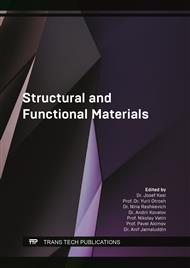[1]
Đồng Kim Hạnh, Dương Thị Thanh Hiền: Tình trạng ăn mòn bê tông cốt thép và giải pháp chống ăn mòn cho công trình bê tông cốt thép trong môi trường biển Việt Nam. Tạp chí Khoa học Kỹ thuật Thủy lợi và Môi trường, ISSN: 1859-3941, 44-49 (2011).
DOI: 10.58845/jstt.utt.2022.vn.2.57-65
Google Scholar
[2]
Bộ Tài nguyên và Môi trường VN: Kịch bản biến đổi khí hậu và nước biển dâng cho Việt Nam, 188p, (Hà Nội, 2016).
DOI: 10.31219/osf.io/b9h56
Google Scholar
[3]
Shuo Zhang: The performance and service life prediction of high performance concrete in sulfate and acidic environments, Doctor of Philosophy (PhD), 171p. (Miami, Florida 2015).
DOI: 10.25148/etd.FIDC000151
Google Scholar
[4]
Mark G. Alexander: Marine Concrete Structures - Design, Durability and Performance, Pages 1-13 (Book • 2016).
Google Scholar
[5]
Lê Minh, Khương Văn Huân: Đặc điểm môi trường nước phèn chua gây ăn mòn bê tông cốt thép công trình thủy lợi ở đồng bằng sông Cửa Long. Viện KH Thủy lợi miền Nam, pp.29-34, (Tapchivatuyentap.tlu.edu.vn, 2014).
DOI: 10.46242/jst-iuh.v43i01.592
Google Scholar
[6]
Nguyễn Khoa Điềm: Khai thác tiềm năng đất phèn bằng biện pháp thuỷ lợi. Nhà xuất bản Nông nghiệp (1986) , 174 trang.
Google Scholar
[7]
Tran Dang An, at el.,: Chemical Characteristics of Surface Water and Groundwater in Coastal Watershed, Mekong Delta, Vietnam. Procedia Environmental Sciences 20 (2014).
DOI: 10.1016/j.proenv.2014.03.085
Google Scholar
[8]
Leocadio Sotor Sebastian, Bjoern Ole Sander, Elisabeth Simelton, Ngo Duc Minh: The drought and salinity intrusion in the Mekong River Delta of Vietnam - Assessment report. CGIAR Research Centers in Southeast Asia 2016 (Vietnam), 56 p.
Google Scholar
[9]
Tran Le Luu: Remarks on the current quality of groundwater in Vietnam. Environ Sci Pollut Res 26, 1163–1169 (2019). DOI 10.1007/s11356-017-9631-z.
DOI: 10.1007/s11356-017-9631-z
Google Scholar
[10]
Quang-Khai Ha et al.,: Identification of freshwater - saltwater interface in coastal areas using combination of geophysical and geochemical methods: A case study in Mekong Del-ta, Vietnam. IOP Conference Series: Earth and Environmental Science 652 (2021) 012006.
DOI: 10.1088/1755-1315/652/1/012006
Google Scholar
[11]
XIAO Han, TANG Yin, LI Haiming, ZHANG Lu, NGO-DUC Thanh, Deliang CHEN, TANG Qiuhong: Saltwater intrusion into groundwater systems in the Mekong Delta and links to global change. Advances in Climate Change Research. Available online 12 May 2021.
DOI: 10.1016/j.accre.2021.04.005
Google Scholar
[12]
Tran Dang An, at el.,: Chemical Characteristics of Surface Water and Groundwater in Coastal Watershed, Mekong Delta, Vietnam. Procedia Environmental Sciences 20, 712 – 721 (2014), http://creativecommons.org/licenses/by-nc-nd/3.0/.
DOI: 10.1016/j.proenv.2014.03.085
Google Scholar
[13]
Mehta, P. K. and Haynes, H: Durability of Concrete in Seawater. Journal of the American Society of Civil Engineers Structural Division 101(ST8), 1679–1686 (1975).
DOI: 10.1061/jsdeag.0004131
Google Scholar
[14]
Mehta, P. K: Concrete in Marine Environment. Elsevier Applied Science, London. (1991).
Google Scholar
[15]
Fedosov S. V., Rumyanceva V. E. Kas'yanenko N. S. Mathematical modeling of mass transfer in the processes of concrete corrosion of the second type. Stroitel'nye materialy, 7, 35-39 (2008).
Google Scholar
[16]
Kayumov R. A., Fedosov S. V., Rumyanceva V. E. et al.: Mathematical modeling of the corrosion mass transfer of the heterogeneous system "liquid aggressive medium-cement concrete. Special cases of the solution. Izvestiya KGASU, 4(26), 343-348 (2013).
Google Scholar
[17]
Fedosov S. V., Rumyanceva V. E., Kas'yanenko N. S., Krasil'nikov I. V.: Non-stationary mass transfer in the corrosion processes of the second type of cement concrete. Small values of Fourier numbers, with an internal mass source. Izvestiya vysshih uchebnyh zavedenij. Seriya: Himiya i himicheskaya tekhnologiya, 58(1), 97-99 (2015).
Google Scholar
[18]
Fedosov S. V., Rumyanceva V. E., Krasil'nikov I. V., Loginova S. A.: Investigation of the influence of mass transfer processes on the reliability and durability of reinforced concrete structures operated in liquid aggressive environments. Stroitel'nye materialy, 12, 52-57 (2017).
Google Scholar
[19]
Sergey V. Fedosov, Varvara Eu. Roumyantseva, Viktoriya S. Konovalova, Svetlana A. Loginova: Mathematical modeling of diffusion processes of mass transfer of free calcium hydroxide, during corrosion of cement concretes. International Journal for Computational Civil and Structural Engineering, 14(3), 161-168 (2018).
DOI: 10.22337/2587-9618-2018-14-3-161-168
Google Scholar
[20]
Sergey V. Fedosov, V.E. Rumyantseva, I.V. Krasilnikov, V.S. Konovalova, A.S. Evsyakov: Mathematical modeling of the colmatation of concrete pores during corrosion. Magazine of Civil Engineering, No. 7, 198-207 (2018).
Google Scholar
[21]
Tsivilis, S., Batis, G., Chaniotakis, E., Grigoriadis, G., Theodossis, D. Properties and behavior of limestone cement concrete and mortar. Cement and Concrete Research, 30, 1679–1683 (2000).
DOI: 10.1016/s0008-8846(00)00372-0
Google Scholar
[22]
Levandovskiy, A.N., Melnikov, B.E., Shamkin, A.A.: Modeling of porous material fracture. Magazine of Civil Engineering, 69(1), 3–22 (2017).
Google Scholar
[23]
Travush, V.I., Karpenko, N.I., Erofeev, V.T., Rodin, A.I., Smirnov, V.F.,: Development of Biocidal Cements for Buildings and Structures with Biologically Active Environments. Power Technology and Engineering. 2017. 4(51). Pp. 377–384.
DOI: 10.1007/s10749-017-0842-8
Google Scholar
[24]
Patel, R.A., Perko, J., Jacques, D., De Schutter, G., Ye, G., Van Bruegel, K.: Effective diffusivity of cement pastes from virtual microstructures: Role of gel porosity and capillary pore percolation. Construction and Building Materials, 165, 833–845 (2018).
DOI: 10.1016/j.conbuildmat.2018.01.010
Google Scholar
[25]
Kolchunov, V.I., Dem'yanov, A.I. The modeling method of discrete cracks in reinforced concrete under the torsion with bending. Magazine of Civil Engineering, 81(5), 160–173 (2018).
Google Scholar
[26]
Fedosov, S.V., Roumyantseva, V.E., Konovalova, V.S., Loginova, S.A. Mathematical modeling of diffusion processes of mass transfer of «Free calcium hydroxide» during corrosion of cement concretes. International Journal for Computational Civil and Structural Engineering. 2018.
DOI: 10.22337/2587-9618-2018-14-3-161-168
Google Scholar
[27]
Luo, J., Chen, X., Crump, J., Zhou, H., Davies, D.G., Zhou, G., Zhang, N., Jin, C.: Interactions of fungi with concrete: Significant importance for bio-based self-healing concrete. Construction and Building Materials, 164, 275–285 (2018).
DOI: 10.1016/j.conbuildmat.2017.12.233
Google Scholar


